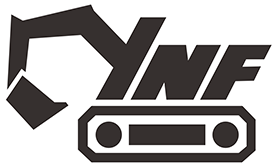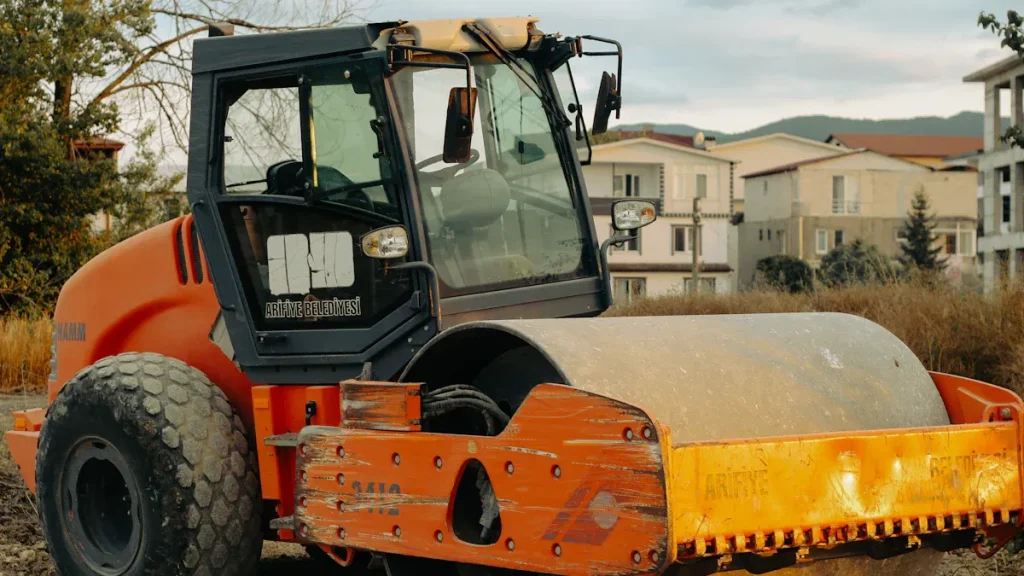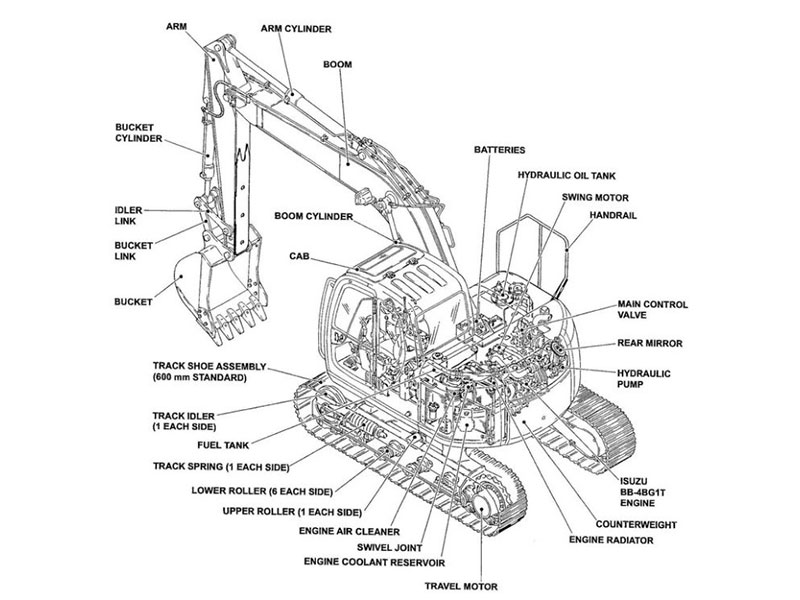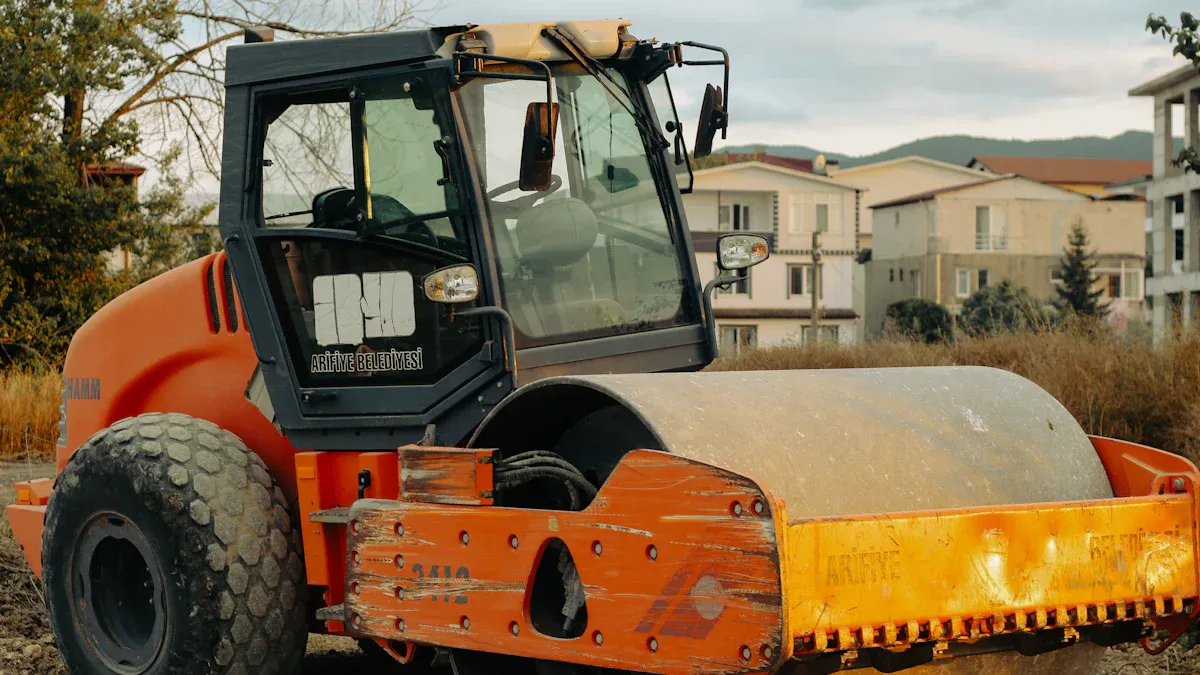
You want your excavator to work well and last a long time. Picking the right excavator roller parts helps your machine work better. It also makes it safer and less likely to break down. Good parts make your equipment more reliable and help you work more. You get even more value if you follow a careful process:
Make sure the parts fit your excavator to stay safe.
Choose tough materials and new ways of making parts for better quality.
Pick suppliers who help you with service and repairs.
Use this advice to avoid problems and finish your projects on time.
Key Takeaways
Pick excavator roller parts that fit your machine well. This helps stop damage and keeps your machine working smoothly. – Choose strong, high-quality parts to help your excavator last longer. Good parts also make your machine work better. – Think about the ground and the work your machine does. This helps you pick rollers that wear out less and save money on repairs. – Buy parts from trusted sellers who give warranties and good help after you buy. This makes you feel safe about your purchase. – Check and take care of your roller parts often. This helps you find problems early and keeps your excavator safe.
Excavator Roller Parts Overview
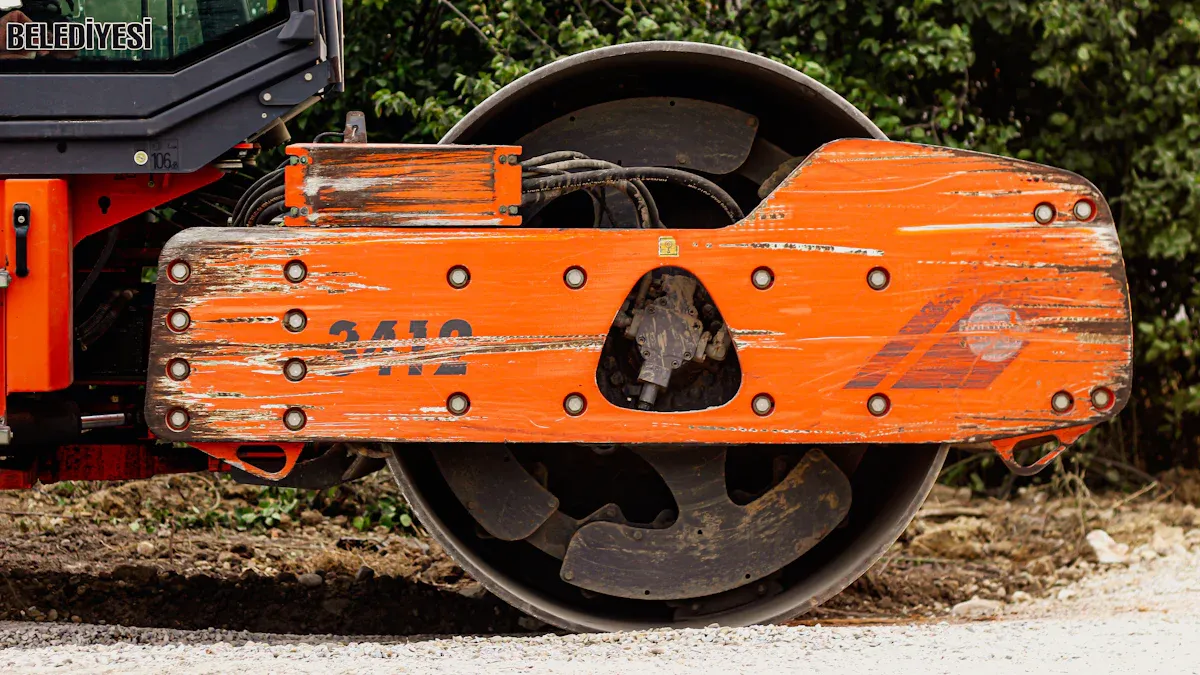
Role in Excavator Performance
Excavator accessories help your machine work well. Excavator roller parts are very important for movement. These parts are found in the undercarriage. They help hold up the track chain. There are two main types of used excavator parts:
Track rollers are under the track chain. They carry the excavator’s weight and spread it out. This keeps the track chain tight. It also helps the excavator move on rough ground.
Carrier rollers, or support wheels, are near the top of the track frame. They hold up the top part of the track chain. They keep the track chain in the right place.
Both types of used excavator parts help the machine move smoothly. They stop the track from rubbing on the frame. You should check and take care of these parts often. Doing this helps stop early wear. It also keeps your excavator working well.
Tip: Clean and oil these parts often. This stops dirt and water from causing harm. It is an easy way to make your undercarriage parts last longer.
Importance of High-Quality Excavator Parts
High-quality excavator parts are important for every job. Good parts help your machine work better and break down less. These parts keep your excavator steady, even on rough ground. Good excavator roller parts keep the track chain straight and lower friction.
If you choose the right used excavator parts, you save money over time. High-quality parts last longer. Some top rollers can work for 3,000 to 5,000 hours if you care for them. The right parts also keep your machine safe. They help you finish work faster. Always pick quality when you choose used excavator parts and other accessories. This helps your undercarriage parts support your machine for many hours.
Compatibility with Your Machine
When you pick excavator parts, make sure they fit your machine. Using the wrong parts can make your excavator break or not work right. You can stop these problems by checking if each part fits your machine.
Matching Model and Specifications
You must match roller parts to your excavator’s model and specs. First, find your machine’s make, model, and serial number. You can check the ID plate or look in the user manual. Every excavator has its own design details. If you use parts that do not fit, your machine can get damaged or work badly.
Look in the manual for the right part numbers and specs for rollers. This helps you avoid mistakes that cost money. When you talk to suppliers, give them your machine’s info. Good suppliers will check their stock and help you pick the right undercarriage parts. Always ask for papers that show the parts fit your machine. Doing this makes sure the parts work well and your machine runs its best.
Tip: Buy excavator parts from trusted sellers who give warranties and help after you buy. This makes you feel safe and helps if you have problems later.
Before you buy, check the parts for good quality and strong materials. Good parts last longer and help your machine work better. Change old parts for new, strong ones to stop breakdowns and keep your excavator working hard.
Considering Terrain and Workload
You also need to think about the ground and how hard your machine works. The type of ground changes what rollers you need. Rocky or muddy ground is harder on undercarriage parts. If you work on flat ground, you may not need the toughest rollers.
The ground type (like rocky, muddy, or rough) changes how much your rollers wear out. Some rollers need better seals and stronger metal for tough jobs.
How hard your machine works and the job type matter too. Heavy work needs rollers that can take more damage.
Picking the right undercarriage parts for your ground and work helps your machine last longer and saves money on repairs.
Excavator bottom rollers hold up the machine and take a lot of force, especially on rough ground. Rollers made from strong steel or special metals last longer and fight damage. Sealed bearings and easy grease spots help you take care of the rollers, even in hard places.
The environment also changes how fast rollers wear out. The table below shows how things like water, heat, and sharp dirt can hurt rollers:
Environmental Factor | Effect on Excavator Roller Wear Rate | Explanation |
|---|---|---|
Moisture | Makes rollers wear out faster | Water causes more rubbing and rust. Wet dirt sticks to parts and wears them out. |
Abrasive Materials | Causes a lot of wear | Hard, sharp dirt scratches and hurts rollers. Harder dirt means more damage. |
Packing Materials | Wears rollers by getting stuck | Clay, sand, and junk can get between parts and rub them. Some stuff gets pushed out, but some keeps rubbing. |
Temperature | Changes how rollers wear | Hot weather can make steel soft and hurt seals. Cold can make steel break and stop grease from moving, which wears parts out. |
You should always think about these things when picking excavator parts. This helps you choose the right kind and quality for your work. By making sure parts fit your machine and job, you help your excavator last longer and save money on repairs.
Quality and Condition of the Parts

Material and Manufacturing Standards
You need to check the material and build of used excavator parts before you buy them. High-quality components use strong steel or special alloys. These materials help the rollers last longer and work better. When you look at the rollers, check for smooth surfaces and even coloring. Good rollers do not have cracks, dents, or rough spots. The best excavator parts come from factories that follow strict rules for making parts. These rules make sure each part fits well and works right.
You should also check how the rollers fit on your machine. If the part does not fit tight, it can cause more wear and damage. Always ask the supplier if the part meets the standards for your excavator. This helps you get high-quality excavator parts that keep your machine running strong.
Tip: Look for parts with clear markings or labels from the maker. These show the part passed quality checks.
Signs of Wear or Defects
You must inspect used excavator parts often to catch problems early. Worn rollers can make your machine shake or move poorly. Here are some signs to watch for:
Oil leaks around the roller seals
Cracks or chips in the metal
Rollers that do not spin smoothly
Flat spots or uneven wear on the roller surface
Rust or pitting on the metal
You should clean and check the rollers after every use. Every 40 hours of work, or at least once a week, do a full check of the undercarriage. If you use your excavator in tough places, check even more often. Always look at both sides of the undercarriage. Sometimes one side wears out faster than the other.
If you see any of these problems, replace the used excavator parts right away. This stops bigger problems and keeps your machine safe. When you change rollers, think about changing other worn parts at the same time. This helps all the high-quality components wear evenly and last longer.
OEM vs Aftermarket Options
You have two main choices when you buy used excavator parts: OEM (Original Equipment Manufacturer) and aftermarket. OEM parts come from the same company that made your machine. These parts fit perfectly and come with strong warranties. Many owners pick OEM because they trust the quality and know the part will work well. Surveys show that most companies see lower repair costs and less downtime when they use OEM parts.
Aftermarket parts come from other companies. These parts often cost less and are easier to find, especially for older machines. Field studies show that some aftermarket parts can match or even beat OEM parts in durability and performance. Good aftermarket parts can save you money and work just as well if you buy from a trusted dealer.
Here is a simple table to help you compare:
Aspect | OEM Parts | Aftermarket Parts |
|---|---|---|
Upfront Cost | Higher due to brand and testing | Lower price, no brand backing |
Durability | Very durable, tested to meet standards | Quality varies, sometimes less durable |
Compatibility | Perfect fit for your machine | May not fit as well, can cause more wear |
Warranty & Support | Strong warranty and support | Sometimes limited or no warranty |
Long-term Maintenance | Lower costs, fewer repairs | Can be higher due to more frequent repairs |
Availability & Downtime | Sometimes hard to find, may cause delays | Easier to find, can reduce downtime |
You should pick OEM if you want the best fit and long-term value. Choose aftermarket if you need to save money or find parts quickly. Always check the quality and condition of the parts before you buy. Good maintenance and proper installation help both types last longer.
Note: Investing in the right components, whether OEM or aftermarket, helps your excavator work better and last longer.
When you replace used excavator parts, try to change rollers and related parts together. This keeps wear even and helps all high-quality components work as a team. You save money and avoid surprise breakdowns by keeping the quality and condition of the parts in mind.
Choosing Reliable Suppliers for Excavator Parts
Supplier Reputation and Expertise
Picking a good supplier helps protect your money and machine. A supplier’s reputation shows if they keep their promises. You should find suppliers with lots of experience and happy customers. Good suppliers talk clearly and act professional.
To pick the best excavator parts brand, try these steps:
Look at how long the supplier has been in business and how they treat customers.
Ask for certificates like ISO 9001 to show the parts are real and good quality.
Read reviews from other buyers on trusted websites like MachineryTrader or Parts Supply House.
See how fast and helpful the supplier is when you first talk to them.
Make sure they have many parts, so you can buy everything you need from one place.
Check if their prices and payment rules work for your budget.
Ask for papers that prove the parts are real and meet quality rules.
Tip: Go to trade shows or industry events to meet suppliers face to face. This helps you see if they know their stuff and are trustworthy.
A good supplier will always give you clear details about their parts and services. They will help you choose the right excavator parts brand, making your work easier and better for your business.
Warranties and After-Sales Support
Warranties and return rules are important for saving money on excavator parts. Good suppliers give strong warranties and let you return bad parts. After-sales support means you get help with putting in parts, fixing them, and answering questions. This help keeps your machine working and saves you money.
Here is a table to help you spot fake parts and avoid trouble:
Counterfeit Sign | What to Check | What to Do |
|---|---|---|
Poor packaging | Look for bad printing or mistakes | Say no if the box looks wrong |
No warranty | Always ask for warranty papers | Don’t buy if there’s no warranty |
Low prices | Prices much lower than normal | Be careful, check if it’s real |
No return policy | Ask about returns before you buy | Only buy if you can return parts |
Always ask for warranty details, return rules, and proof of quality before you buy. Good suppliers give you these papers right away. They also help you after you buy, which saves you money and trouble. If you stick with one supplier, you may get better deals and service, which helps your business even more.
Note: Good after-sales help and clear warranty and return rules mean fewer repairs, less waiting, and more value for your business.
Step-by-Step Selection Guide
Preparing for Inspection
You need to get ready before you check any excavator accessories. Start by gathering the right tools. Use hammers and punches to test mechanical parts. Bring digital diagnostic tools to find hidden problems. Always have a detailed inspection checklist. This list should cover all accessories, including rollers, sprockets, shoes, and links. A checklist helps you look at every part and not miss anything important. Clean the excavator accessories before you start. Dirt can hide cracks or leaks. Make sure you have enough light to see small details. When you prepare well, you can spot issues that are hard to see.
Inspecting and Selecting Excavator Roller Parts
When you inspect used excavator parts, look for signs of damage. Check for dents, scrapes, or fresh paint. Fresh paint can hide old repairs. Look closely at the tracks for wear. Check for leaks around hydraulic parts. Use your checklist to look at bolts, guides, guards, and drive components. Make sure all bolts are tight. Replace any damaged guides or guards. Look for bent or broken shoes on the track. These can cause more damage if you do not fix them. Examine sprockets and drive parts for oil leaks and loose bolts. Check cotter pins on the master link. Clean away any debris from the tracks. Adjust track tension if it feels loose. These steps help you pick the best excavator accessories and avoid buying bad used excavator parts.
Tip: Always inspect bucket and breaker selection as part of your routine. These accessories work with rollers and affect how your excavator moves.
Keeping Essential Parts on Hand
You should keep extra excavator accessories ready at your worksite. Store rollers, sprockets, and other used excavator parts in a safe, dry place. This helps you fix problems fast and avoid long delays. Make a list of the most-used accessories for your machine. Include bucket and breaker selection on this list. Check your stock often and replace items you use. Having the right accessories on hand means you can keep working, even if something breaks. Choosing the right parts and storing them well saves you time and money.
Note: Keeping extra used excavator parts and accessories ready helps you finish jobs on time and keeps your excavator running strong.
Picking the right excavator accessories means making sure parts fit your machine. You should check each accessory to see if it is good quality. Use diagrams and manuals to help you find the right roller parts. Work with trusted suppliers who give you warranties. Grease your accessories often and replace them when needed. This helps your excavator work well and saves money by stopping breakdowns. Good accessories last longer and make your machine better. They also help you avoid losing time when your machine stops working. Keep important excavator accessories nearby. Listen to expert advice to get the best use from every accessory you have.
FAQ
How often should you inspect excavator roller parts?
You should check your excavator roller parts every 40 hours of use. If you work in tough conditions, inspect them more often. Regular checks help you find problems early and keep your machine running well.
What signs show that a roller part needs replacing?
Look for oil leaks, cracks, rust, or flat spots. If a roller does not spin smoothly, replace it. Uneven wear or strange noises also mean you need a new part.
Can you mix OEM and aftermarket roller parts?
You can mix OEM and aftermarket parts, but check that each part fits your machine. Mixing can cause uneven wear if the quality or size does not match. Always follow your machine’s manual.
Why does terrain matter when choosing roller parts?
Different ground types wear out rollers at different rates. Rocky or muddy ground needs stronger rollers. If you match the roller to your work site, you help your machine last longer.
What should you ask a supplier before buying roller parts?
Ask for warranty details, proof of quality, and return policies. Check if the supplier has experience with your machine’s brand. Good suppliers answer questions and provide support after your purchase.
